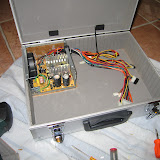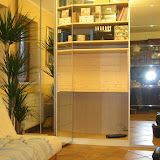Flying with a simulator is my preferred hobby.
Well not as good as snorkeling but during german winter it is far much better to find some indoor activity!
I bought my first home computer, a Commodore 64, after playing with my cousin's flight simulator in far 1986.
As the time passed I changed several computers and flown almost all the simulators available on the market.
Actually i am flying with the Microsoft flight simulator X.
The main reason driving this choice is that the MS FS is the most supported product for third party hardware and software.
There two kind of flight I love. One is an unruled VFR when I do not want to think about anything: just start the engine, take off, watch out for the landscape and eventually land safely somewhere.
I love to fly in place I know very well, like around Trieste or Cagliari. Sometimes when i have to go somewhere for vacation or for job i like to fly around a little bit to have an idea of the place before arriving.
At the present my preferred plane for VFR is ATR 72-500 from Flight1.
I found the plane and its systems very well done; for me one of the most complete turbo prop plane one the market.
My choice for IFR flights is the
767 LevelD.
I think one on the best planes to fly with a good reproduction of the real systems, frame rate friendly and I know this product since the the PIC version.
I fly Condor because I like the company, the colors and the livery.
My flight are usually quite short because the best parts of a flight are departure and landing.
I find quite boring to stay in front of a PC simulating a long flight between Frankfurt and Los Angeles just monitoring the FMC until is time to start the descent.
It is better to plan a flight like Munich-Rome for example having the time for a little rest after turning off the passengers lights and and before preparing the descent.
I like to fly trying to emulate the reality so I do not use tools like navigators and so on. I only have my plane and possibly other pilots and ATCs around me.
In fact I always fly online, with IVAO.
Given that I am not a real pilot, I admit that my vision of reality is miles far away...
My IVAO id is 108576 and today I have 934 hours logged in the system. A lot of time.. around 39 days.
After years flying online and offline I have decided that having one screen and a 4-axes joystick was not enough and I have decided to have a better setup.
The dream is to fly without touching the keyboard.
I am still far from that but i am actively working on it building my version of an home cockpit.
My PC is Scaleo from Fujitsu-Siemens as follows:
- CPU Intel pentium 4HT, 3.2Mhz
- RAM 2Gb 400Mhz
- 2 HD SATA of 150Gb each
- Graphic card ATI Radeon X1800XT dual head, 512Mb, PCI Express
- LAN Ethernet
- WLAN netgear on a PCI card
- 19" LG monitor running at a resolution of 1280x1024
- 17" Samsung monitor running at a resolution of 1280x1024
The operating system is Windows XP home, unfortunately in german that makes solving problems very time consuming.
With such a hardware configuration the flight simulator runs at around 15fps not very high but fortunately FSX is smooth enough.
Under certain conditions like bad weather and heavy online traffic it slows down to about 10fps and sometimes I have some short stop of around half second that at the prsent is not big problem.
I am thinking to an upgrade of course.
I foreseen to buy a new PC after next summer: at the present I am a little bit concerned about dual core machines and Windows Vista.
The following picture shows my initial setup for flying.

The picture was taken when I bought the MCP and the EFIS from
CPFlight to flight with 767LD.
At that time I was aware that the hardware is not for 767 but for 737 but the 737 buttons are mapped in the 767 ones.
I am quite satisfied but I have to say that CPFlight system is not 100% bugs free; in particular it happens from time to time that the MCP turns black and non responsive during final approach phase and the HDG reset to 0.
This last bug is quite annoying because if in lateral mode, the HDG reset to 0 and the plane starts to run toward 360.
I use the biggest monitor with the main view of FSX.
I still fly with the traditional 2D view but I am trying to get used to the virtual cockpit that is much more useful especially for taxing and flight preparation.
The virtual cockpit is much more useful and realistic but with the 2D I have everyting available at a glance.
When my home cockpit will be ready, I guess I do not need the 2D anamore and I can safely switch to virtual cockpit
The second monitor contains secondary panels like pedestal, overhead, FMC, IVAP together with charts.
I do not use tools like IVAE, QuteScoop, FSNavigator and so on because I think the reduce the realism.
The joy is a
Saitek X45.
X45 is not produced any more but is still a good product having the main stick with 2 axes and the throttle handle with an axis to control ailerons and the nose gear.
There are enough buttons to raise and lower the flaps, apply differential brakes, push to talk, main brakes and so on. In this way I can afford approaches and landings without the help of the keyboard.
Just a few words more about the picture upon.
The 767LD is at LIEE, both engines off, and I was testing the hardware from CPFlight. You can see a lot of cables in the left side that connect the MCP to the windows box and to the power, other cables connect the 2 parts of the joy together and the USB socket.
When I installed the MCP and the EFIS I was still stuck to a traditional way of simulating. I was really surprised of the improvements the hardware gave to the realism and I start thinking to build a kind of home cockpit to fly reducing the interaction with the keyboard and the mouse.
This was the start of my dream and a new hobby: build my prsonal version of an home cockpit.
I will talk you more about that in one of my next posts.
This post has been written by copy and paste from my home page.
The original content will be removed from my home page very soon.
 The green box is the bigger squared pipe. The litle pipe, inside the green box, is represented by a black box.
The green box is the bigger squared pipe. The litle pipe, inside the green box, is represented by a black box.






















